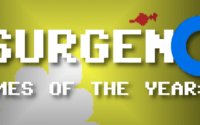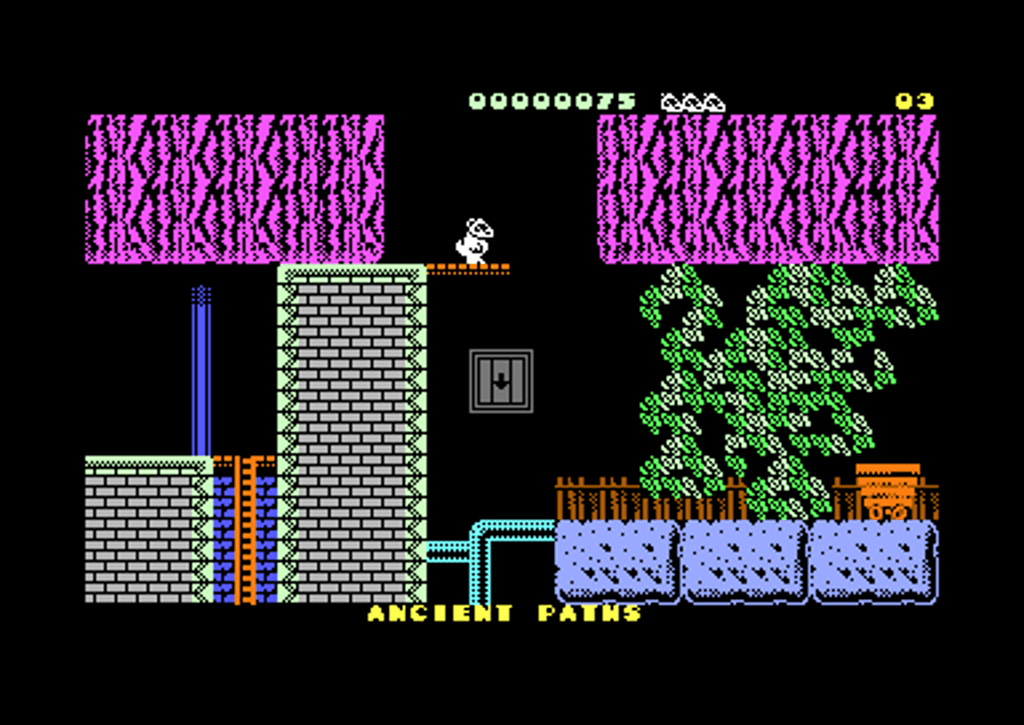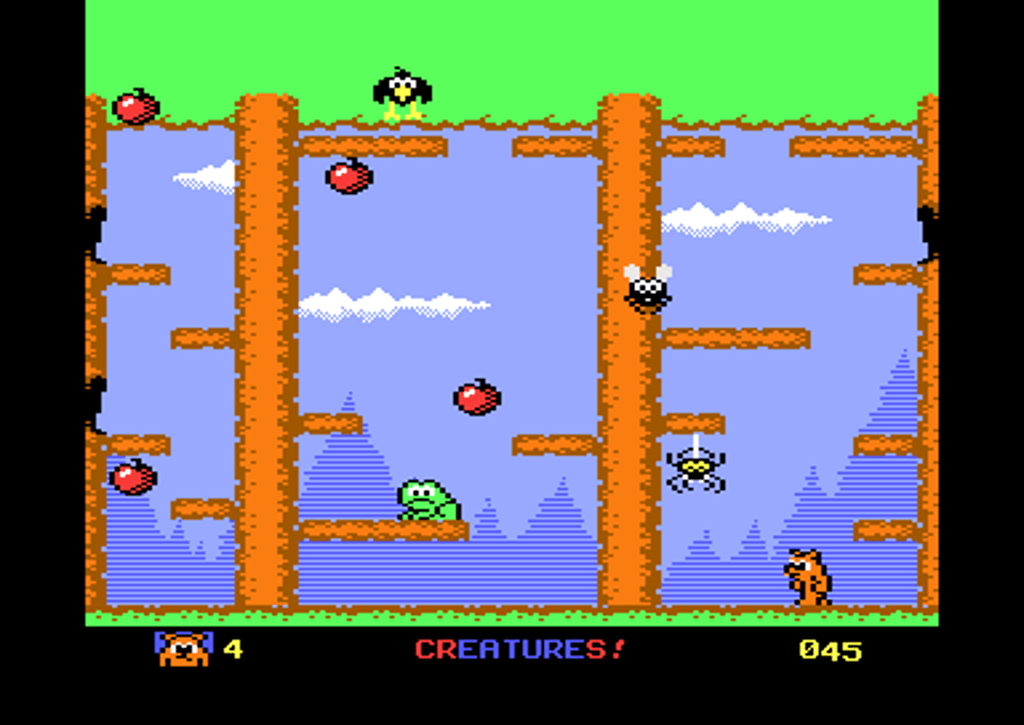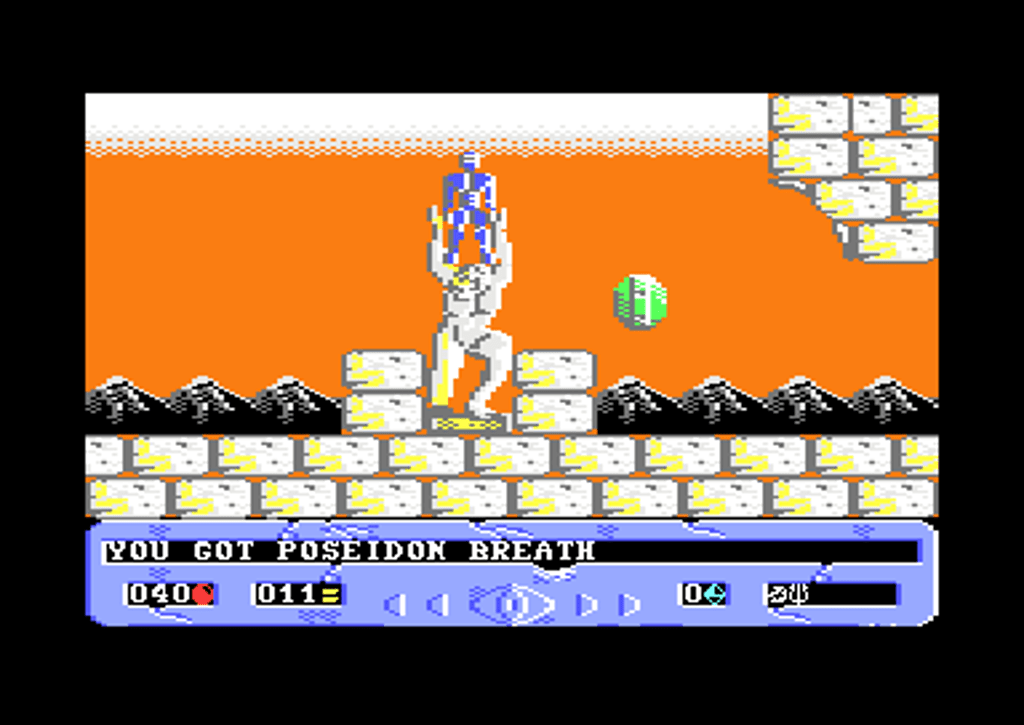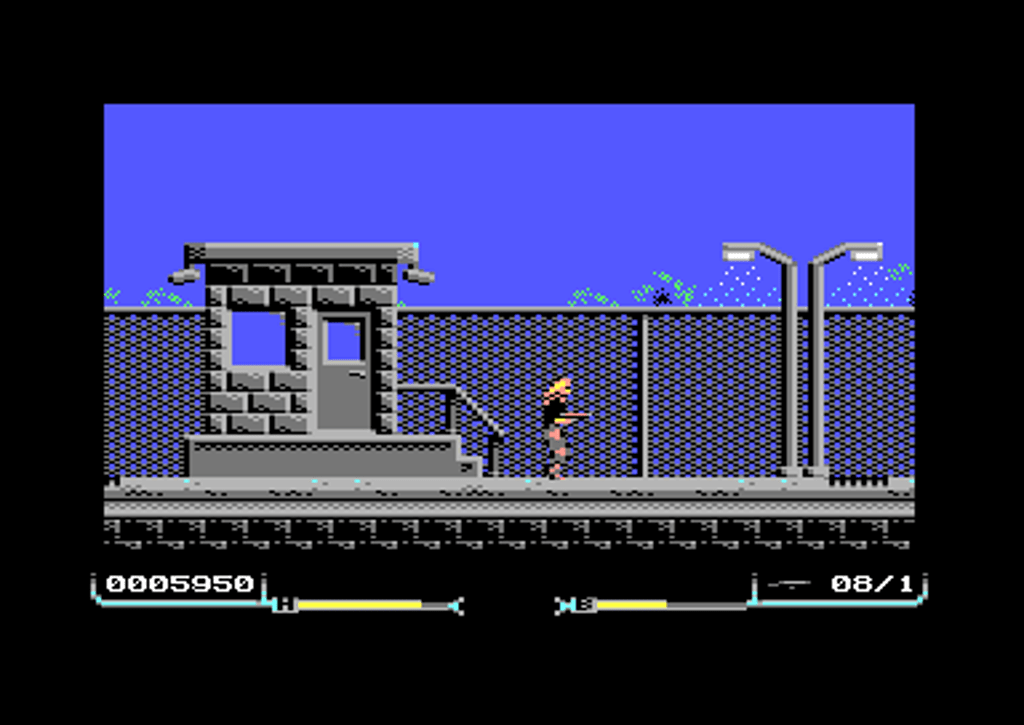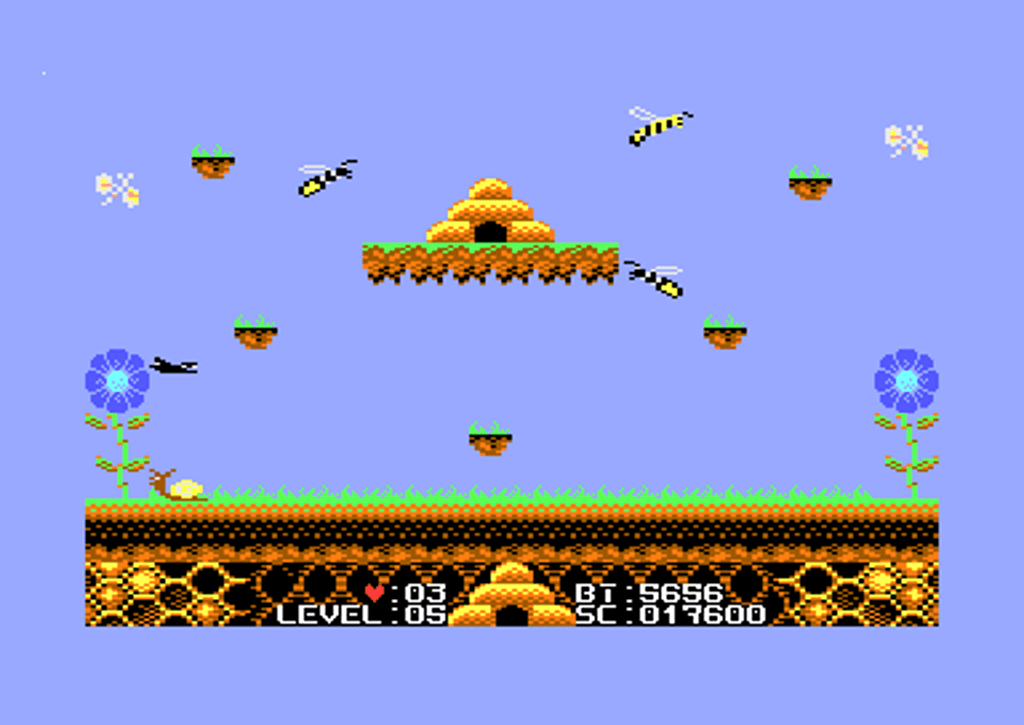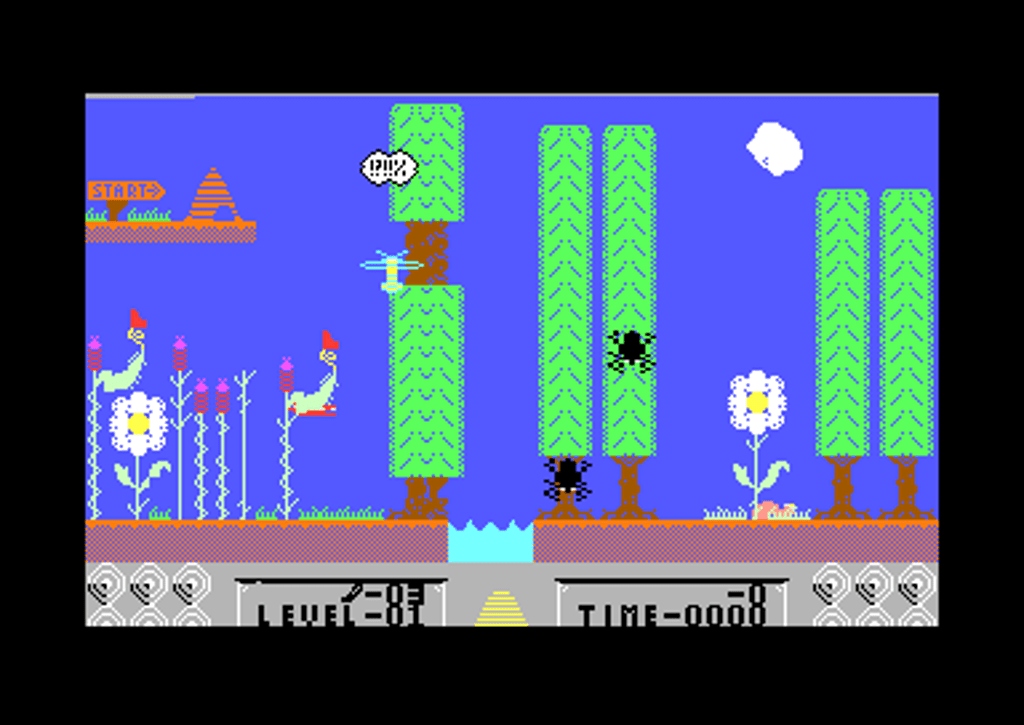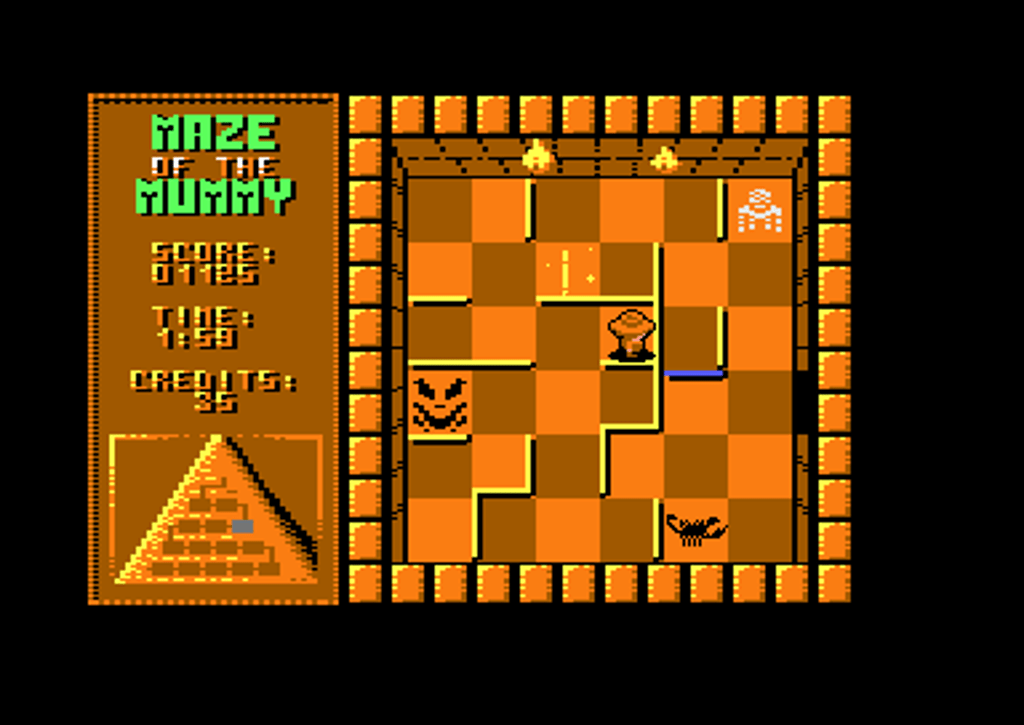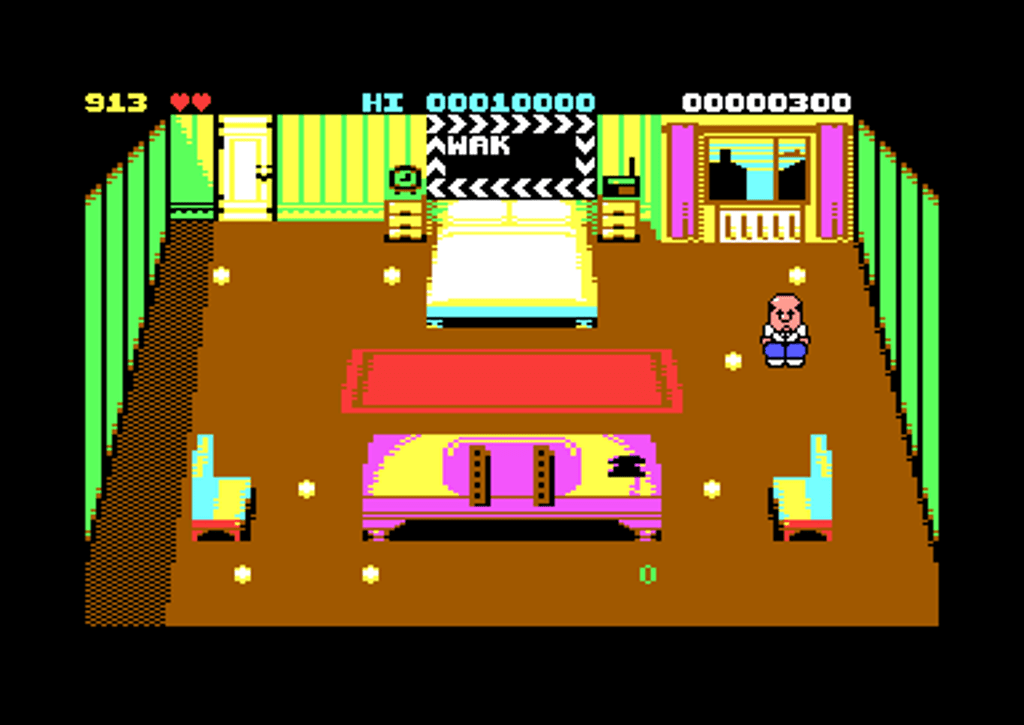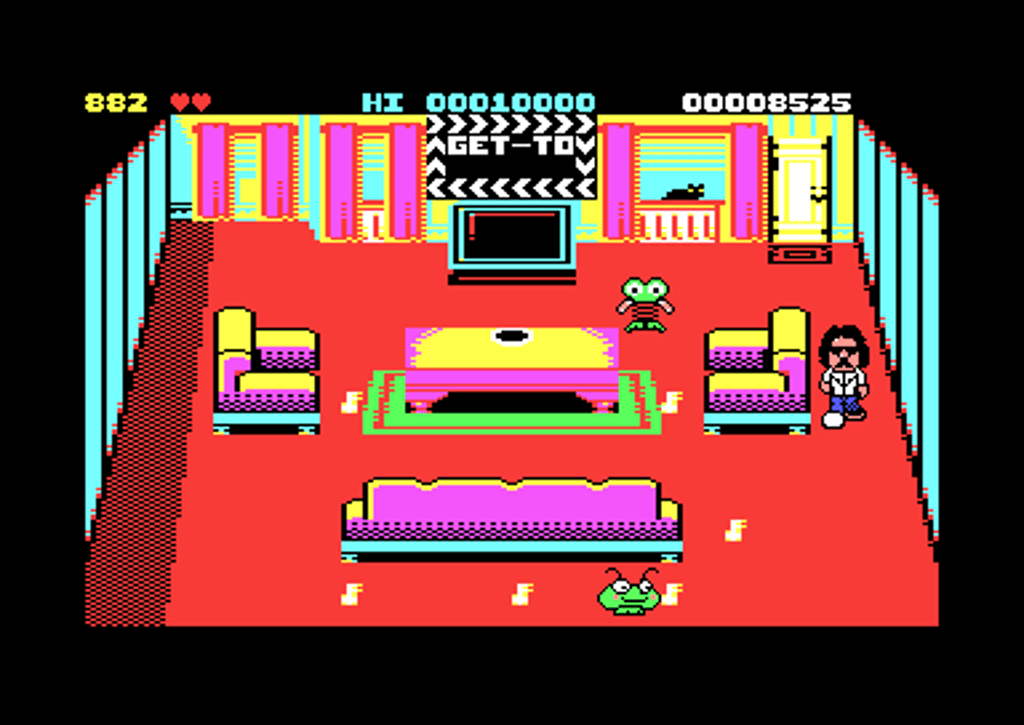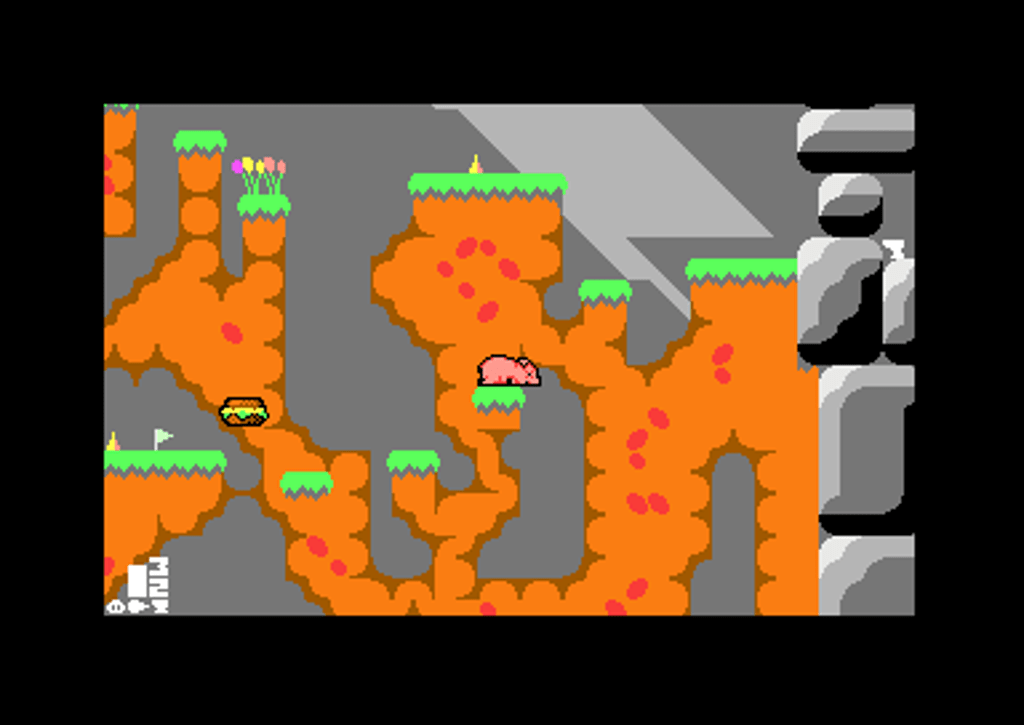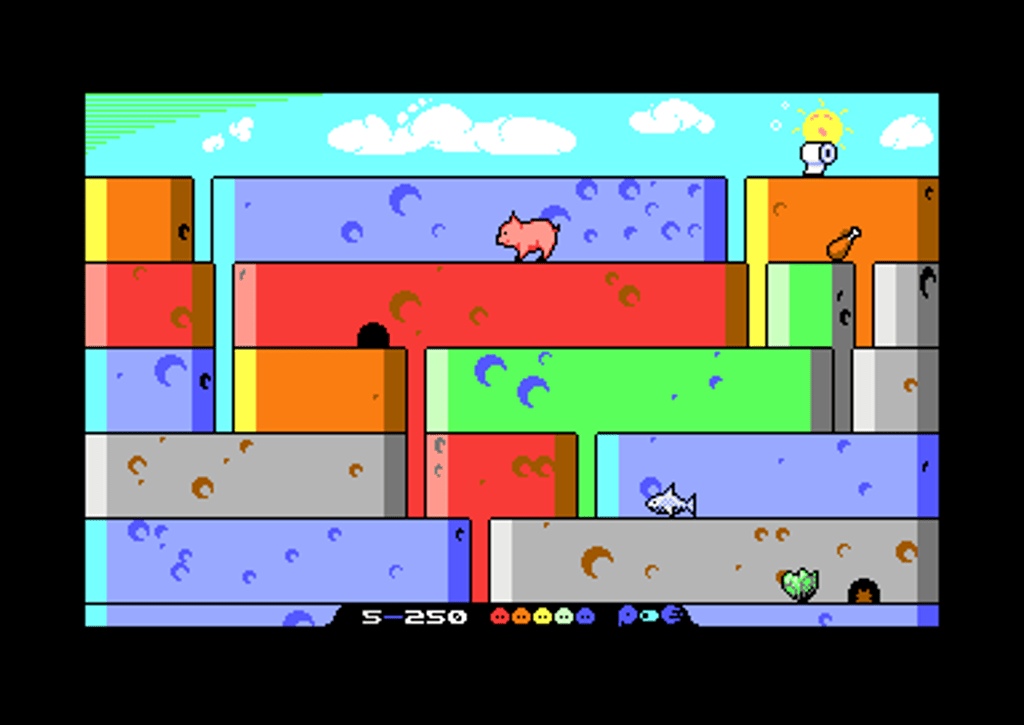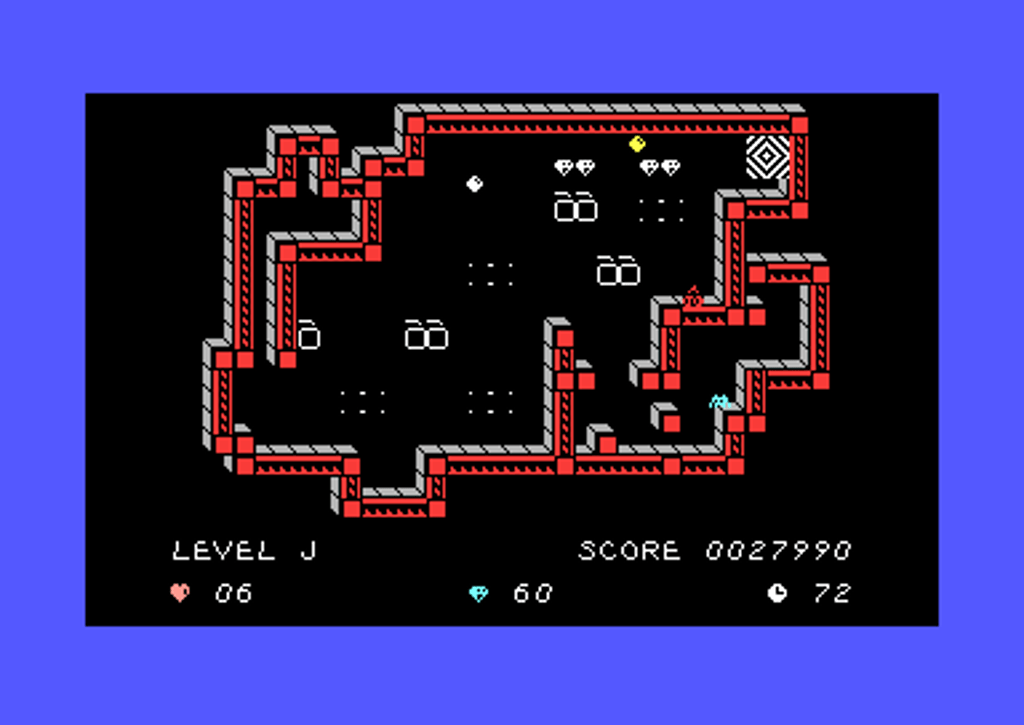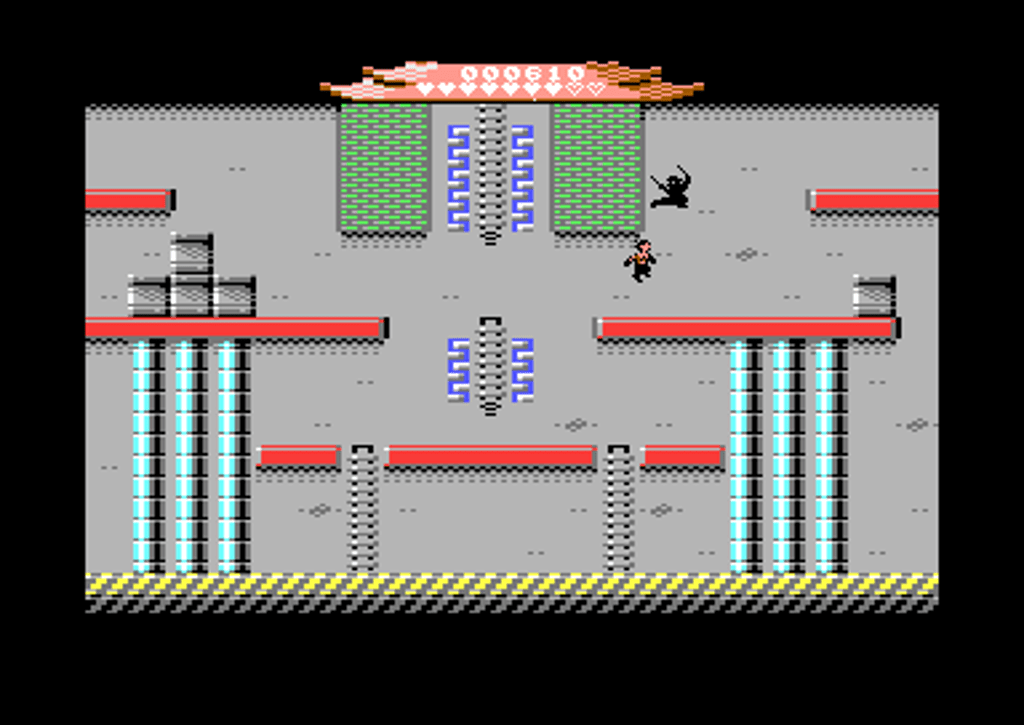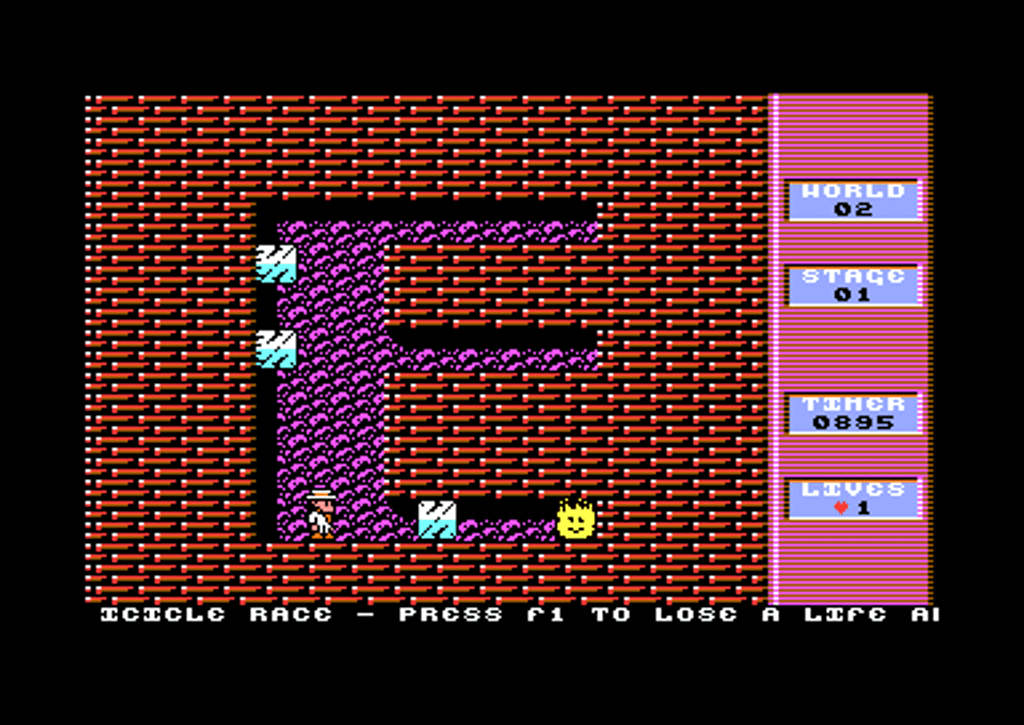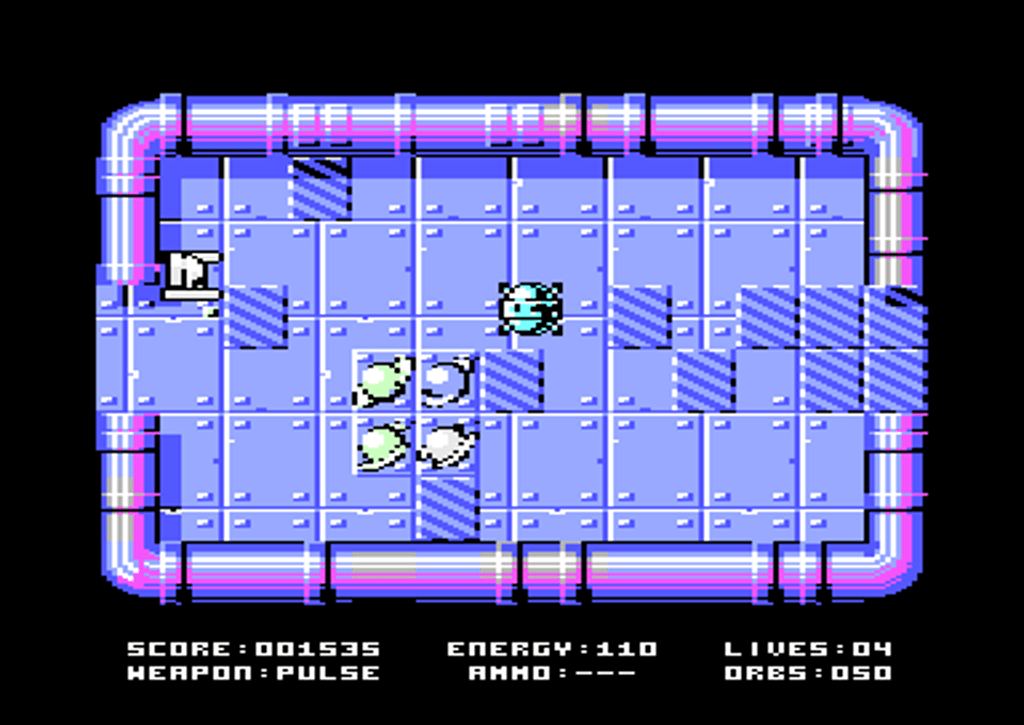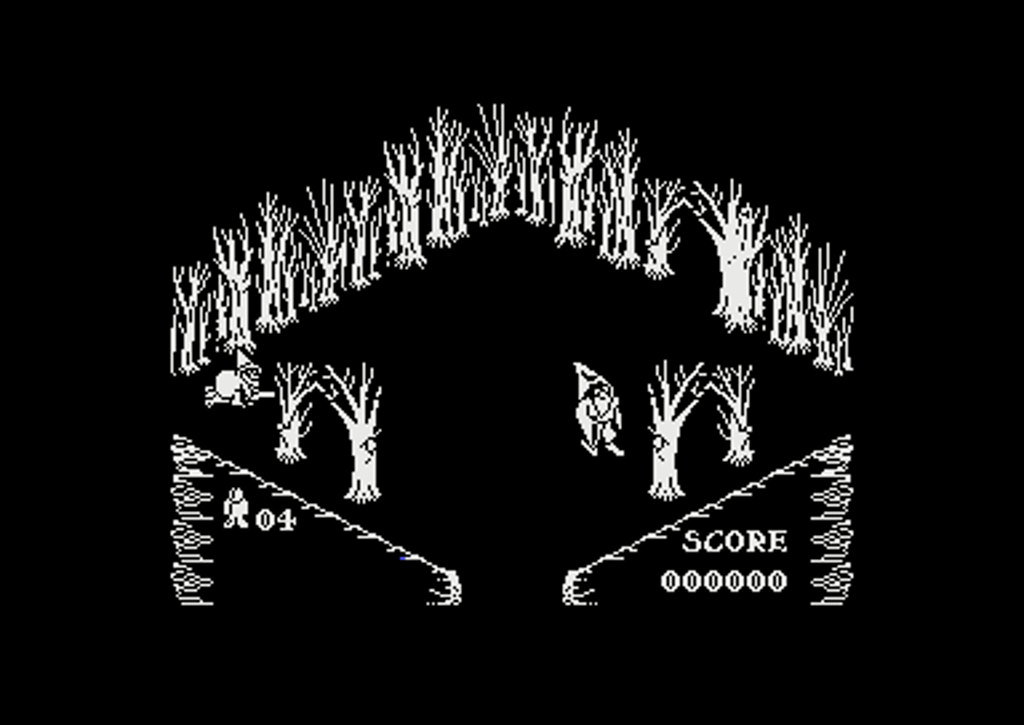Resurgence C64 – 10 Games Of The Year: 2016

Yeah, I know… Still in shock? I’d be too if I had been away from the C64 since the late 80s. The shock of course comes from discovering the quality of the games that were released in a year like 2015… We just took a look at ten of them – With the never fading hopes that you too will examine them closer. Because it’s easy to say with absolute conviction that: 2015 was only the “beginning” and that this Resurgence brought a powerful momentum in its wake…
And now, without even further delays, here’s a bunch of definite candidates for Games Of The Year from 2016…
1. Barnsley Badger
Psytronik Software
A badger with gambling problems spiraling out of control sets out to settle his debts by finding a treasure. You always need a good Plan A.
As far as we know, Monty Mole is still living happily on Montos and has done so since 1987’s Auf Wiedersehen Monty, but that doesn’t mean that we never wanted to play another Monty game after that “good bye”. (Impossamole counts too, I guess. But at the same time, it kind of doesn’t.) And who knows if he’ll return from his retirement one day…? But until then, we can always help another relatively small mammal solve his economic problems.
Enter Barnsley Badger. Barnsley is a pub-dwelling gambling animal and his behavior has eventually put him in a bad situation money-wise. But he has now heard about this big treasure that once belonged to the legendary Tutanbodger. (As you immediately realize, this game is based on true, historical events.) And it just so happens that there is a subterranean network beneath his favorite pub “The Dog And Duck” and “Saint Sid’s Church”. (Now that sounds like a church that one would like to visit regularly and become a member of… As long as they play SID-music instead of psalms.) Barnsley takes the first best ladder into the dangerous underground and so the adventure begins.
If you are familiar with flip-screen arcade adventures on either the C64 or the ZX Spectrum, you will immediately recognize the internal structure and logic of Barnsley Badger. (These games do have their own rules and standards!) Which translates to: 1) Avoid basically everything that moves. And 2) The things that don’t move are most likely stuff that you can collect or pick up. The characteristic background graphics either consist of platforms and corridors, traps and hazards, or surfaces that Barnsley can climb on. (Vines, pipes, etc.) Scattered around the map (12×12 screens big.) are different items that Barnsley can find, including a catapult (and ammo), potions, gold coins, etc. The catapult is activated with the Fire-button, and that’s the only time Fire is used. To jump, you push the stick of joy upwards. Barnsley has this anti-gravity trick that lets him roll through the air after a jump. (By pushing the Joystick in upward diagonal directions.) That might sound like it makes the game much easier since you “create” invisible platforms to move on, but it “merely” makes the game possible to finish. The factor of challenge is always present. Barnsley Badger is a wonderful throwback to everything Old School from the genre that can be crammed into one single game. There is plenty to discover and the controls are excellent.
The game was programmed by Georg Rottensteiner (Who has coded games like Soulless, Pocket Dungeon, Penultimate Fantasy, and Joe Gunn. Plus the extraordinary Awakening from the year before.) Trevor Storey, who previously pixelled Darkness and Rottensteiner’s Guns ‘n Ghosts, created the graphics. The title- and in-game music (Pretty good tunes.) was made by Andrew Fisher. The tune can be switched for sound effects (by Hugo Hoekstra) if you prefer the slightly more quiet soundscapes of these types of games. — 1 Player · Joystick · Disk / Cassette (Physical + Download)
Buy Barnsley Badger from https://psytronik.itch.io/barnsley-badger-c64 and you get the complete map in .png-format. (If nothing else, it shows the incredible variation of the game’s sections.)
2. The Bear Essentials
Pond Software
When you need to survive a winter that’s absolutely coming – 350 apples is all that’s needed.
That is, if you happen to be a bear… Mr. Bear has been taking the concept of relaxing and chilling to whole new levels all summer until Mrs. reminds him about another concept – The one of survival. She sends Bear out into the wild to collect apples that happen to be spread out over five worlds around the home base. These apples don’t simply grow on trees and Bear just needs to touch pixels with them to add them to the accumulating family stash. Any attempt to return home results in Mrs. making it very clear that Bear doesn’t need to return unless he completes his task. That’s how serious things are around here.
And it looks easy to begin with as Bear ventures into the flip-screen forests. So there are quite naturally animals in those. They often move around the screens in fixed patterns, and they have to avoided. That’s the universal platform game law. (More specifically, platformers that don’t have energy-bars.) A screen usually has more than exit, and each world has a number of apples. The worlds are called Forest, Cloudy, Rocky, Jungle, and Mining. (Which has a charming reference to a certain rubber-keyed computer – The mine happens to hide glowing apples, but the place was shut down in the 80s after a “whole SPECTRUM of problems”.) Make it to a junction (Check point screen.) with exits to other worlds, and you are awarded one continue. Each round gives you five lives. Extra lives are rewarded via Bear’s good friends. (Another charming reference to a certain Thalamus game.)
You control Bear with the left- and right directions on the Joystick plus the Fire-button. (Which is for jumping. And you can control Bear mid-air.) It’s not impossible to memorize the layout of the slightly labyrinthine levels, and after a couple of rounds, you should know all the shortcuts. But the 2017 version of Bear Essentials auto-maps your journey, and the map can be viewed separately. There is also a password screen for when you get to the Mining world. This part of the game gets unlocked once you have completed the previous set of worlds. (For a good reason, one might add. You probably need to warm up to the (excellent) controls first – To the point of knowing them in your sleep more or less.) Bear Essentials was created by Graham Axten (Who is behind games like Bonkey Kong, RockMaze, etc.) during a two year period, and it’s a clear labor of love. Each screen is well thought out and everything about it just likable. (Axten also created the graphics, sound effects, and the catchy music.) It’s like a genuine treasure from an 80s time capsule. (And it gets challenging for real once you start “getting somewhere”!) The game has been released in a couple of different version. It was updated in 2017 and then again in 2018. The latter version gives the player the option to save his / her progress. It also includes a Hi-score saver. — 1 Player · Joystick · Disk / Cassette / Cartridge (Physical + Download)
Bear Essentials can be downloaded on a “Name your own price”-basis via https://axtevision.itch.io/the-bear essentials – But physical editions exist on all the common formats and can be bought via poly.play
3. Eye Of The Gods
Psytronik Software
Every Masterpiece needs a spiritual successor… So could this be one…?
This may not be yet another opportunity to indulge in some fanboy-like gushing over Denton Designs (One of the most innovative game developers in video game history deserves a separate article!), but a game that has “[something] Of / FromThe Gods” in the title could and should automatically catch the attention of those who ever played and loved Gift From The Gods (Ocean, 1984) on the ZX Spectrum. One thing that Denton never stooped do was milking sequels to the last lifeless pixel, so a sequel to “Gift” wasn’t perhaps anything that anybody ever waited for.
But Retro Dreams and David Rodriguez gives us the next best thing – Eye Of The Gods – Another flip-screen arcade adventure that references Greek Mythology, albeit not as directly. (Not even close, as a matter of fact.) And speaking of Mythology, Richard Bayliss’ absolutely wonderful title-screen- / in-game tune is a clear homage to Jeroen Tel’s masterpiece in System 3’s Myth – History In The Making… Eye Of The Gods actually takes place in the far future, in the Doom age. After the development of technology drained Earth’s resources, civilization has been brought to its knees. And humanity followed. In a desperate attempt to save everyone and everything, the Army sends you into the ancient ruins in the “Cradle Of Civilization” to retrieve the Eye Of The Gods… Because it doesn’t look good to begin with. You can’t even fight or defend yourself in your blue battle suit – Only make stiff jumps. (Straight up, or in arcs to the right and left. You can’t control the direction of the mid-air jumps either.) This is where the inherent bad-assery of the “Orbs Of Destiny” come in. They have to be found, of course. They are always held up by a statue like Atlas holding the Earth, and there are six of them: Zeus Lightning gives you the ability to shoot things that hurt, Poseidon Breath lets you breathe under water, Ares Destruction gives you power to smash walls into dust, Hermes Boots puts you in the Olympic high jumping elite, Athena Shield is for accessing claustrophobic places, and Hades Vision gives you night vision.
The earliest screens don’t have that many environmental hazards (You can fall several screens high without taking any damage.), but when there are things that start shooting at you, you can’t just rush past everything without draining valuable health. Health is restored by picking up red orbs that enemies randomly leave behind when destroyed. And when you (early on) get the Zeus Lightning, you can also find ammo for that. Eye Of The Gods may not look like a top game right when it begins, but it has soul and an addictive nature that gradually reveals itself as you progress. (And the map is quite big…! That’s always a big Plus in the book of any arcade adventurer who doesn’t feel like investing time or energy into a game that’s going to end in ten minutes anyway.) And it’s well worth discovering everything. But as usual – Everybody won’t love it. (A genre-fanatic should, though.) — 1 Player · Joystick · Disk / Cassette (Physical + Download)
Eye Of The Gods is available from the “usual places”: https://psytronik.itch.io/eye-of-the-gods-64 (for $2.99) and https://binaryzone.org if you prefer boxed releases.
4. Hessian
Psytronik Software / Covert BitOps
Lasse Öörni returns after the excellent quadrilogy that was the Metal Warrior series…
… And to say that the return is glorious is yet another understatement. It’s one thing to see a modern indie game do what Hessian does on a modern computer with all those gigahertzes. But it’s an entirely different show to see everything in it contained inside 170 kilobytes. (One side of a 5.25″ C64 floppy disk!) And there were no doubts that the game itself would be great in the wake of a whole series of hard-rocking hits that blended arcade-like gameplay with a story that easily could’ve become a bunch of cool 80s style Actionsploitation movies. Hessian is no exception – You get everything that’s great in six categories: Story, gameplay / mechanics, graphics, sound effects, music, and sheer lastability…
You play this multi-directional scrolling side view arcade adventure as security guard Kim at the Throne Group Science Complex. The last thing she remembers is being gunned down during an attack on the complex. When Kim is revived, she discovers that she has been enhanced via the wonders of nanotechnology – The real downside being that Kim’s vital organs now run on battery power…! Meanwhile, the hostilities around the complex continue, and the situation now has to be resolved in a more direct and traditionally confrontational way, i.e., get out there, find out what’s going on, and wipe out the threat using various weapons… Kim controls via an ingenious Joystick layout. She walks and rolls left and right, and the upwards diagonal directions are used for either jumping or climbing stairs. (Which means that you can jump directly onto the steps, or walk up them by using the up- and left / right directions in a sequence. Depending on which direction the stairs lead in, obviously.) Joystick + Up is for operating gadgets and machines, and down is for ducking, picking up items, or walking down stairs. The Fire-button is mainly for guess-what, but also for using items, and flipping through Kim’s inventory. (This is how you use eight directions and one button to its full capacity.) You might also prefer to use the keyboard for selecting items, using medi-kits, etc. And that’s an option too. Hessian uses five keys in-game. During your shooting orgy, you also meet various people that you can communicate with.
Events and key scenes drive the story ahead, and there is a lot going on across 700 (!) screens. The scenes load very quickly, giving the game a seamless continuity. (Not surprisingly when you run the game from cartridge.) Lasse Öörni and Péter Nagy-Miklós wrote some excellent tunes to go along with the action. (The complete OST has 21 tunes!) You can play Hessian with both music and sound effects, or without one or the other. And naturally, there is more in the game than what you see during the first levels. (Including tons of details and touches here and there.) Since this isn’t a ten minute game, you can save your progress in one of the five slots accessed via the title screen. Hessian is simply a must. It’s a standard setting title. Just don’t let it be the first C64 game you ever play, because there will be trouble finding an equally well made and satisfying one. — 1 Player · Joystick + Keyboard (Optional) · Cartridge / Disk (Physical + Download)
Hessian is available for $1.99 at https://psytronik.itch.io/hessian – v1.3 updates the disk loader, plus an cartridge version of the game is added to the digital download. v1.1 and v1.2 include multiple improvements to the gameplay.
5. Honey Bee
Psytronik Software
Well, not even video games claim that gathering pollen is easy…
Read between the lines, and there might be a very important environmental message in Honey Bee. (Always topical, right?) The game stars Buzzy the bee, and Buzzy is the only being actually doing something to keep the cycle of nature going while making sure that there is a constant flow of honey… Just perhaps not merely out of his own will as it’s the Queen Bee who has sent out Buzzy on this unbelievably dangerous mission.
If you didn’t sleep throughout the entire school, you might know that pollen comes from flowers, and that bees collect it from those. Honey Bee operates on the exact same mechanics. Buzzy has to collect the pollen from each flower on each of the sixteen single-screen levels, and then deliver it to the beehive. The actual pollen gathering in the game doesn’t take more than a split second. All Buzzy needs to do is to approach the center of the flower. This center “disappears” on screen, and this means that Buzzy now carries some pollen. Pressing the Fire-button drops the pollen, and this has to be done right above the entrance to the beehive. Drop it elsewhere, and Buzzy loses a life. The same happens if he collides with other insects, wasps, and various stuff in the surroundings. (Including house walls and tree branches.)
To make the game even possible to play, there are usually not that many flowers on each level. After you deliver the last load of pollen, Buzzy finds himself flying on a horizontally scrolling bat cave. The only objective is to avoid crashing into the bats. If Buzzy manages to make it to the other side, he gets an extra life. (And an additional one every 10.000 points.) Apart from the number of lives and level number, the panel below the playing area displays “SC” and “BT”. “SC” is the score, and “BT” stands for “Bonus Timer”. The latter one counts down fast towards zero, and if you don’t complete the level before that happens, you get exactly that many Bonus-points. (Luckily, you don’t need to pay with another life.) Honey Bee is simple enough to get into, but it might take a couple of tries to figure out what the hell you can fly past and what to avoid without dying instantly. But it’s “classic arcade”-fun, and the real nightmare begins somewhere halfway through the game.
Richard Bayliss programmed the whole thing and did some of the graphics along with Wayne Womersley, Steven Day, and Johan Janssen. Joachim Wijnhoven composed the very jolly music. (Except the nice loading music that also was done by Bayliss.) Honey Bee is simply put a nice little gem that could have been an NES classic in some alternate universe. It sure has the gameplay to match. A speed runner could possibly complete it in a couple of minutes, but… Not some of us. And not on the first hundred tries or so. — 1 Player · Joystick · Disk / Cassette (Physical + Download)
Honey Bee was originally an entry for the RGCD C64 16KB Cartridge Game Development Competition in 2014. A preview of the game surfaced earlier that year, which looks vastly different from the “Redux” version. (It was also published by The New Dimension.) The Final Version includes “The Honey Bee Slideshow” that shows the 32 old level designs along with information about the game as a scroll-text. It also has seriously good music by, once again, Mr. Bayliss.
The digital version of the game is available for free at: https://psytronik.itch.io/honey-bee-c64-free.
6. Maze Of The Mummy
Psytronik Software / Magic Cap
Loot a couple of pyramids and avoid the very persistent mummy… Well, it helps if you are clever with games that require consequential thinking. (Such as Chess.)
This is of course if Chess only had two pieces, a couple of obstacles, and the objective was to escape the board… Or something… Anyway. A grave robber’s life can never be easy – Especially not when the ambitions are set as high as relocating treasures from pyramids. Because that’s how you get a couple of mummies after your ass as soon as the search for the treasure vaults begins.
Maze Of The Mummy is the first game from Italy-based game developer Magic Cap. To my knowledge (After some lazy Googling as usual.), I couldn’t find other games from this team, except previews for Pushover64. (Which would be the 8-bit version of the Amiga game.) Either way, I hope Magic Cap returns with another C64 game soon enough since they clearly know the machine. Maze Of The Mummy is a single-screen level top-down puzzle game set in fifteen different pyramids. The levels look a bit like Chess-boards with checkered floors (Most of them have walls, and some of the have locked doors and traps.) and the goal in each level is to always get to exit before the mummy catches you and robs you of your credits. (Only fair, I guess – Steal and you get stolen from.) But you don’t lose all your credits every time you bump into each other, but the game is over when you can’t fork out some cash for another retry. Prepare to be chased by that bloody mummy around 255 levels in totals. The strategic aspect of the proceedings would be that every time you take a step, the mummy takes two. This creates the turn-based gameplay, and the tactical part is to use the walls to your advantage. The mummy always tries the shortest path to get to you. So as long as there is a wall in front of the mummy, you can move on the other side of wall in a straight line without the mummy being able to move at all. The scorpions move one step at the time, so those can’t get to you as long as you don’t get trapped in a dead end. When the scorpions and mummies collide, they take each other out. That’s another good strategy to use – To try to affect their paths so that they cross. No enemies on screen means that you can safely walk to the exit… Which has to be done before time runs out.
If you love these kinds of logical “thinking games”, there is plenty to do in Maze Of The Mummy. The game also features an “Undo” mode if you realize that you fucked up. But it can only be used a limited number of times during one game. Once the first levels have taught you the mechanics, you can start cultivating that brain ache over the upcoming levels. The uncomplicated controls sure as hell help. And Sascha Nagie’s great soundtrack is a big Bonus. Maze Of The Mummy was developed in 2014, but it wasn’t published until July 2016. — 1 Player · Joystick · Disk (Physical + Download)
As usual, Psytronik distributes both the boxed and digital versions of Maze Of The Mummy. Go to: https://psytronik.itch.io/maze-of-the-mummy-c64 and hand over $2.99 for a download.
7. My Life / Rob’s Life
Psytronik Software / Icon64
“… But tomorrow is another day he must get through. He had a longer way to run, or so the story goes, life full of fun where did it go…”
Getting through an ordinary week is tough business – You have to wake up way too early, circumvent multiple annoyances, survive the trip to work, endure the day, and get back home in one piece. The only two things worth looking forward to is: 1) Friday comes closer one hour at a time. 2) Friday itself. Eugene is a dude with exact these frequently occurring problems, and I’m sure some of us can relate. Not only that – Eugene’s hairline has crept in multiple directions towards its final destination, and he is slowly growing in the walking direction.
These daily routines would have been soul-murderously boring in a video game, so My Life turns them into something that reminds of Imagine / Konami’s old classic Mikie. Eugene has to walk around the single-screen level and jump three-four times on a number of items (Letters, keys, etc.) that litter the floor / ground. Enough jumps (Performed by holding the Fire-button pressed.) on any item in any order transports it to a small text board at the top of the screen where the item turns into a letter. The number of items equal the same number of letters that eventually spell a short sentence, and that’s when the exit opens. The game is divided into the weekdays, and Monday is obviously so shit that Eugene can’t even get to work. After getting out of the house, he has to collect his mail. Which is followed by blackout time as it’s suddenly Tuesday. Maybe he can get to work some day…
My Life is not without other instances of surrealism and symbolism. In the house, Eugene is chased by a vacuum cleaner as the radio attempts to numb him with horrendous music. (Except the OST is good and catchy.) This is obviously a symbolism for procrastinating cleaning. And the music from the radio is symbolized as a note that paralyzes Eugene momentarily. (To shake the shock, you have to waggle the Joystick left and right.) Outside, the mailman tries to hit you with unwanted mail. And so on. Eugene moves freely around the levels in eight directions, and each level is about avoiding and running away from problems and accidents. How else are you going to be able to relax on Friday…?!
My Life was updated in 2017 as Rob’s Life. This game is a part of the Project Hubbard Kickstarter campaign, and in this version, you play as none other than 80s Rob Hubbard who has a hard week to get through…! Rob only need to stomp on the items once, but on the other hand – He is sometimes chased by Things (On a spring.) and Gribblies. (On a day out.) The levels and backgrounds are pretty much the same, but the most important difference is that Hubbard himself composed the loading-, title screen-, and ending tune. (With Jason Page.) Excellent all of them, of course – They sound perfect and has the vibe… As far as I know, this game was the first collaborative effort between Achim Volkers (programming), Trevor Storey (graphics), and Saul Cross (music) for Psytronik Software. Both versions of the game is well worth getting and playing, but mostly Rob’s Life if you want to hear some new Hubbard grooves…! (The loading tune is called “Casio”, and the title-screen tune is called “Don’t Step On My Wire”.) — 1 Player · Joystick · Disk / Cassette (Physical + Download)
My Life Final Version: https://psytronik.itch.io/my-life for $2.99. Disk images of Rob’s Life are available on certain well known sites.
8. Quod Init Exit IIm
www.retream.com
First there was BOH and Huenison… (Those are the names of two existing games.) So how are they connected to an unbelievably cute pig that farts fire?
The official saga does actually connect these aforementioned games with Skillgrid, MAH (Released for the C64 in 2015. v2.0 came out in 2018.), and KOG. (That’s three more games.) But you don’t need to know anything about them in order to play this multi-directional scrolling platform game from Simone “saimo” Bevilacqua. With that being said, the game has a pretty convoluted history that the manual chronicles. Quod Init Exit is Latin and means “Whatever goes in, comes out.” The “IIm” after the title stands for “secundum minimum”, which refers to the game being a sequel as well as its size. (“Minimum” as is “not big”. The official web page mentions that the map is 2048 x 688 pixels, which would be somewhere around 6 x ~3.5 screens.) The finished game will be called “IIo”, which stands for “secundum opimum”. And that would be the “fat second” game. (With five worlds instead of one.) The update from saimo mentions the game being in development for three years as of 2020, so maybe it will get released one fine day. (The “To-Do”-list looks pretty “insurmountable” and the development was furthermore affected by the “Covid-19 menace”.)
But until then, you can always play this small version. Quod Init Exit IIm takes places in the world of Suinio – Cotechina the witch, Evil Masters, stolen toilets, a powerful spell, and a nasty gastric influenza is a part of the toilet-humor laden plot. And you, Zampo the pig, have to skip and jump around “The Cliffs” (The first world.) and collect 35 potties that Cotechina then can transform into the Porcelain God. But a pig can’t do anything without a constant intake of food. So Zampo has to eat all the time to not die from starvation. Luckily, food and drink materializes randomly, all the time, around him. The food keeps the “Belly Satisfaction Meter” going and this drink called Gasorade keeps the “Turbofart” level up. The Turbofart is used as a fiery jet stream that makes Zampo fly across short distances. Around the map are numerous switches that unlock sections of the map as well as the Evil Masters that try to stop you in your skidmarks. If you come in contact with any of the nasties, including water, spikes, etc., you’re teleported to the last checkpoint you passed. (A small flag on the ground.) So there is no life counter if you manage to eat and eat again.
The game looks almost as good as a 16-bit game and it runs evenly like clockwork. The controls are good too, but the frustrations caused by missed jumps and badly timed falls off of ledges may very well give you explosive diarrhea (Or at least farts that burn like fire.) if you get irritated and furious enough. Quod Init Exit IIm reportedly takes “half an hour” to get through, and it’s pretty damn good for a single-level platformer. The dedication put into the game goes a very long way, and we can only hope that there eventually will be a complete game available. — 1 Player · Joystick · Cartridge / Disk (Download)
Check out the original and quite different single-screen platformer Quod Init Exit from 2010. (It was published by RGCD and Psytronik Software.) A preview for Quod Init Exit IIo was released in March, 2020. (It’s available at https://retream.itch.io/quod-init-exit-iim.) For $1.99, you get the “IIm” game and the preview for “IIo”.
9. Super Carling The Spider
Psytronik Software / Polygon
When a serious crime needs to be solved, you hire Carling – Even if Carling happens to be a spider.
I definitely recommend you to read the amusing back story for this single-screen platform / puzzle game / Collect ‘Em-Up. It involves a collection of diamonds worth $1 trillion known as “The Rockford Collection” (Reference!), the three Diamond Girls, the Forever Group and their shady CEO Fergus Frier, the BALLS OF STEEL, and, of course the original VIC-20 celebrity himself – Carling the Spider.
The original game was (also) published by Psytronik Software in 2009 and was created by Joe Dixon a.k.a. Polygon / Aqarius. Seven years later, Super Carling The Spider made the leap to the C64. With the extra RAM and the world’s most beautiful sounding single monolithic integrated circuit, Dixon expanded the game’s eight screens to twenty-six. Times three. (Polygon also designed, programmed, pixelled the art, and composed some tunes for the game.) The concept is classic as hell if hell couldn’t get any more classic – Carling has to run and jump around the screens, collect all diamonds, and get to the warp gate on screen. The aforementioned BALLS OF STEEL (They have to be written in capital letters. I’m not making the rules.) are literally bouncing balls that kill Carling upon contact. They appear in different colors (and speeds) throughout the game and the only good thing about them is that they move in fixed patterns. This means that you can figure out how they move. But the BALLS OF STEEL aren’t the only dangers that an honest diamond-looting arachnid can encounter. There may be no rolled-up newspapers or upside-down glasses anywhere in sight, but there are spikes and barbs. Plus springboards and appearing / disappearing platforms in strategic (That’s synonymous for sadistic.) places. Each level has a time limit, but you don’t lose anything should the clock tick all the seconds away – You just don’t get any Bonus-points when you exit. (And that’s disgraceful in itself, of course.) Bonus-points are also awarded if you collect fruit. Hearts and every 100 diamonds grants an extra life.
So what can be said about the game as such? It controls like a dream about good platform games. Carling’s movements and jumps are pixel-perfect. You can move mid-air. And none of that inertia-bullshit that becomes a big (Game breaking even.) problem while jumping on narrow platforms – Spiders don’t just slip like that, and Carling is no different. He stops on a dime. (It continues to amaze that such a small character can be so adorable and well-animated.) Super Carling The Spider has three difficulty modes – Blue, red, and yellow. (More diamonds means more BALLS OF STEEL.) Beat seven levels, and you’re given a password. There are also unlockable secrets and new levels. (When compared to the previous version.) The soundtrack is also worth mentioning. The loading- / title music is one hell of a kicking SID, and the in-game music is bloody good and listenable. (The sound effects are optional, thankfully.) And Robin Levy made one of the cutest loading screens that you have ever seen…! — 1 Player · Joystick / Keyboard · Disk / Cassette (Physical + Download)
Digital download available for free (Or how many bucks you want to give.) at: https://aqarius.itch.io/super-carling-the-spider-c64.
Additional note: Also worth loading up: The separate credit sequence on the disk.
10. Tiger Claw
RGCD / Lazycow
The Beat ‘Em-Up sub-genre solely popularized by Bruce Lee makes a grand return.
Throughout the ages, fans of Ron Fortier’s Bruce Lee might have wondered why there weren’t more Martial Arts-themed games where the entire screen is a fighting area and with multiple attackers. Maybe they’re just that hard to get right. But that Confucius quote in the documentation for Tiger Claw almost becomes a metaphysical thing around the whole thing: “He that would perfect his work must first sharpen his tools.”
And sharpened the tools is exactly what Matthias “Lazycow” Bock and Saul Cross did when they designed and created a game that takes the “Bruce Lee”-concept and upgrades it for the modern ages. The beautiful thing is that the game still uses one Fire-button while it’s a genuine Beat ‘Em-Up and a bloody good action game. Merely the controls are amazing as the protagonist has several punches, kicks, and other forms of attacks. Some of them need a Power-up, but they are still done with one Joystick… Some valuable scrolls have been stolen by a trio of evil Lords, and the scrolls need to be taken back before they are used for utterly sinister purposes. But Master Lee managed to enchant a bunch of masks with powers from the scrolls so that Tiger Claw can use them against the horde of baddies and Ninjas that the Lords send after him… And what an adorable fighting game / platformer combo this is. The pugilists are small and extremely well-defined and animated.
And Tiger Claw controls like if Bruce Lee from the original game was in exceptionally good shape. The map has “more than 24 rooms”, and when a bunch of rabid dogs and Shuriken-throwing Ninjas attack you from all directions, you feel the action. The game is nothing that you casually can rush through. It’s a challenge, for sure. (What else would it be?) Falling damage would have probably rendered the game unplayable, but it’s not like there is a lack of excitement around the screens. A very welcome feature is that Tiger Claw has an energy-bar and that energy can be restored. (With chicken.) The game features three difficulty modes, a “Training Mode” (Which is a non-stop fighting scenario where you learn how to fight – The hard way.), and a “Versus Mode”. This is for multi-player (Local, of course.) where the other players can control the evil Lords. It’s naturally a fight to the death. Except it looks cute… The atmosphere in Tiger Claw is awesome. It’s like an 80s Martial Arts movie in micro format. Only the one-liners, the gratuitous violence, and blood splashes are missing. (Well, you probably don’t really miss any of it in the game…) Saul Cross’ soundtrack consists of eight very good tracks. (They can be played on the title screen, and they appear in the game during specific moments / scenes.) And the OST cements this 80s B-movie vibe until it’s rock hard. Excellent. — 1 – 2 Players (Simultaneously) / 3 – 4 Players (Simultaneously with Joystick adapter) · Joystick · Cassette (Download)
Make sure to get and play the “C64 In Pixels Edition” as it is an optimized and enhanced version of the previous version. (Free digital version for download at: https://rgcddev.itch.io/tiger-claw.)
Additional note: Harping on the same string here, but if you want to play Tiger Claw with 2 – 4 players on a computer / Raspberry Pi and an emulator, the Joystick adapter isn’t needed. You can map any device for the controls, e.g., two players can use the keyboard while player three uses a console-style controller and the fourth one wields a regular Joystick.
…
So many lovely games – Commercial and otherwise. And we’ve got to have a bunch of honorable mentions. It wasn’t easy picking just three when everything was released within the same twelve month period as games like Bug Hunt (By Eric “Majikeyric” Hilaire of Digital Monastery.), Frogger Arcade, Oxyron’s Coin-Op-based version of Donkey Kong, Qwak, Let’s Invade! (From Richard Bayliss / The New Dimension.), RockMaze – Reset Edition, Platman, Pickle’s Pod Patrol!, SID Hero… The list really goes on… But just for the sake of picking three:
Icicle Race (John Christian Lønningdal / Saul Cross) – Will you ever get enough of platforming puzzle games…?! Of course you won’t. And this is another original one created for the RGCD C64 16KB Cartridge Game Development Competition that ran from July 2015 to April 2016. And Icicle Raec deserves a quick mention because it won the compo and because it’s more fuel for the addiction. The game was made by the same guys that brought us Rocket Smash EX. Icicle Race reminds slightly of P.P. Hammer And His Pneumatic Weapon, except here, you conjure and make blocks of ice disappear. The no doubt magic ice is used to put out flames, and you can only affect ice blocks that are below you diagonally to the left or right. You can get squished by the ice, and single blocks can be pushed horizontally across surfaces. Icicle Race has ten worlds with nine single-screen levels in each. (Which should last you a good while!) The worlds and levels can be played in any order, but you only have three lives, and each level has a timer. Pleasant graphics and a set of good tunes make the game even more attractive.
Moonspire (RGCD) – Dušan Milivojević made this very playable and slick flip-screen Shoot ‘Em-Up like they were done back in the days…! Milivojević’s (first) game game started as a one-level “preview” in 2014 before it was developed into this full game with 264 screens (Told ya! Like they were done back in the days!) spread across six levels. You navigate around a maze, collect orbs, and you shoot enemies. What else do you demand from life as a spherical robot? Also: Avoid the enemies that can’t be killed, find the three different weapons, and keep an eye on your energy level… Moonspire features three difficulty levels – Easy, Medium, and Hard. (If you notice that you blast through the game on Easy a bit too quickly and without too much effort.) And a fine soundtrack by Ari “agemixer” Yliaho. So if you’re looking for nothing more and not a damned bit anything less than a clean-cut Shmup on the C64 – Moonspire it is. It’s like a mix of several 80s classics, and that should put a smile on anyone’s face.
Pentagram (Emu / Ultimate Play The Game) – The second sequel to Underwurlde sure took its time to appear on the C64, eh? (The first one, Knight Lore, wasn’t released until 2018… And that lost treasure only known as Mire Mare, we can only keep dreaming about until someone from the “inside” with a photographic memory reveals enough details about it so that Emu and Rod (Or “someone” else.) can develop a re-make…) Anyway. No worries anymore, because Pentagram was finally released thanks to the always painstaking and enthusiastic efforts of Emu, STE’86 and Saul Cross. And what an update it is! The old ZX Spectrum game is the classic that everybody says it is, and this is an Expansion. Not only does the game support C128 and SuperCPU machines for increased speed, but it also has new music (A famous (?) tune that I don’t know the name of.), sound effects / cues, optimized code, and a whole page with “Saberman’s Extra Spells” with time bending / frame skipping, immortality, mega jumps, etc. And it’s such a well done conversion that anyone with the slightest interest in Ultimate’s history should check it out. Emu and company have done the company’s legacy absolute justice.
…
This was another good year, for sure… But… Wait a minute! Where the devil is [game title]…?! … Yeah… I’m pretty certain it’s in someone else’s list of favorites…
2015-16 sort of marks the “beginning” of another era, namely the one where there was a resurgence in games made with Shoot ‘Em-Up Construction Kit. The S.E.U.C.K. Its popularity just never seems to wane completely. In 1988 – Who would’ve ever thought that over a thousand games would be created with Sensible Software’s program during the following three decades? While S.E.U.C.K. can do much, it can’t do side-scrolling games or other stuff out of the box. However, programs can “always” be reverse-engineered. Such is the case with numerous S.E.U.C.K.-made games where shooting mechanics have been modified into, e.g., fighting ones, and where other limitations of the program cleverly have been concealed. While many of these games are and can be charming and fun, they’re simply not, usually, Game Of The Year material. (But it’s a fun side note.)
That was that, and we’re back on June 15th with ten more Games Of The Year, but for 2017…! (How else are we going to catch up with the times?)
Related Posts
